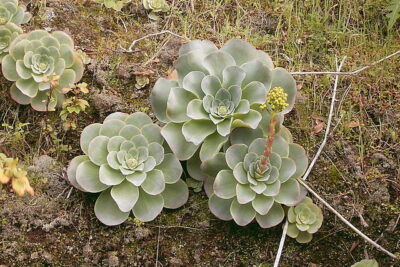
Low-Light Succulents: Thriving Office Desk Plants Without Windows

Many office workers are faced with the challenge of trying to bring a touch of nature into their workspace, only to be hindered by the lack of natural light. Windows are often a luxury, especially in large office buildings or cubicle-filled spaces. However, this doesn't mean that you have to give up on the idea of having plants in your office. There are actually several types of low-light succulents that can thrive in environments without direct sunlight, making them perfect desk plants for those without windows.
We will explore the world of low-light succulents and how they can be the ideal solution for bringing greenery to your office desk. We will discuss the unique characteristics of succulents that make them well-suited for low-light conditions and provide tips on how to care for them. Additionally, we will highlight some popular low-light succulent varieties that are known for their resilience and ability to thrive in artificial light. So, if you've been longing to add some greenery to your workspace, keep reading to discover the wonderful world of low-light succulents.
- Choose succulents that are known to tolerate low light conditions
- Place the succulents near a bright artificial light source, like a desk lamp
- Use a grow light specifically designed for succulents to provide them with the necessary light
- Rotate the succulents every few weeks to ensure all sides receive adequate light
- Avoid overwatering the succulents, as they are prone to root rot in low light conditions
- Use well-draining soil and pots with drainage holes to prevent waterlogged roots
- Provide occasional sunlight exposure by placing the succulents near a window for a few hours
- Clean the leaves of the succulents regularly to remove dust and promote better light absorption
- Monitor the growth and health of the succulents and adjust care accordingly
- Consider using other low-light plants, such as snake plants or ZZ plants, alongside the succulents to add variety to your office desk
- Frequently Asked Questions
Choose succulents that are known to tolerate low light conditions
When it comes to selecting succulents for your office desk that lacks natural light, it is essential to choose varieties that are known to tolerate low light conditions. While most succulents thrive in bright sunlight, there are a few species that can adapt to shady environments.
One such example is the Zamioculcas zamiifolia, commonly known as the ZZ plant. This succulent has thick, glossy leaves that can store water, allowing it to withstand periods of low light. The ZZ plant is also incredibly resilient and can survive in various indoor conditions, making it an ideal choice for your office desk.
Another low-light succulent option is the Sansevieria trifasciata, also known as the Snake Plant. This plant has long, upright leaves with distinctive patterns that can add a touch of elegance to your workspace. The Snake Plant is renowned for its ability to thrive in low light and can even tolerate neglect, making it perfect for busy office environments.
Consider the lighting situation in your office
Before choosing low-light succulents for your office desk, it is crucial to evaluate the lighting situation in your workspace. While succulents can survive in low light, they still require some amount of indirect sunlight to thrive. Take note of the following factors:
 Tips for Growing Succulents Indoors in Low Light Conditions
Tips for Growing Succulents Indoors in Low Light Conditions- The distance between your office desk and the nearest window
- The presence of other artificial light sources, such as desk lamps or overhead lighting
- The direction in which the windows face (north, south, east, or west)
By understanding these factors, you can determine the level of light your succulents will receive throughout the day. This knowledge will help you choose the right varieties and place them in the most suitable locations.
Opt for succulents with darker foliage
In low-light conditions, succulents with darker foliage tend to perform better compared to those with lighter-colored leaves. The reason behind this is that darker leaves contain more chlorophyll, allowing them to absorb light more efficiently. As a result, succulents with darker foliage can thrive even with limited sunlight.
Some excellent choices for low-light succulents with dark foliage include the Echeveria 'Black Prince' and the Aeonium 'Zwartkop'. These varieties not only add a touch of sophistication to your office desk but also require minimal maintenance.
Provide supplementary artificial lighting if necessary
If your office desk lacks natural light completely, you can still create an environment suitable for low-light succulents by providing supplementary artificial lighting. LED grow lights are an excellent option for mimicking natural sunlight and can be easily installed on or near your desk.
Ensure that the LED grow lights you choose emit a full spectrum of light, including blue and red wavelengths. This combination will provide the necessary light energy for your succulents to carry out photosynthesis effectively.
Remember to position the LED grow lights at an appropriate distance from your succulents, as too much light intensity can lead to sunburn or damage the plants. Regularly monitor your succulents' growth and adjust the lighting accordingly.
With the right selection of low-light succulents and proper care, you can enjoy the beauty and benefits of these office desk plants, even without windows. Incorporating greenery into your workspace can improve air quality, reduce stress, and boost productivity, making it a worthwhile addition to any office environment.
 Can Succulent Plants Survive Outside Year-Round?
Can Succulent Plants Survive Outside Year-Round?Place the succulents near a bright artificial light source, like a desk lamp
When it comes to indoor plants, succulents are a popular choice for many. However, one common misconception is that succulents require direct sunlight to thrive. While it's true that most succulents prefer bright light, there are certain varieties that can actually do well in low-light conditions, making them perfect for office desk plants without windows.
One simple solution to provide adequate light for your low-light succulents is to place them near a bright artificial light source, such as a desk lamp. Position the lamp so that it illuminates the plants evenly, simulating the effect of natural sunlight. This will help ensure that your succulents receive the necessary light energy for photosynthesis.
When choosing a desk lamp for your low-light succulents, opt for one with a full-spectrum or daylight bulb. These bulbs mimic natural sunlight and provide a balanced spectrum of light, which is essential for the healthy growth of plants. Additionally, consider using a lamp with an adjustable arm or gooseneck design, as it allows you to easily position the light at different angles to suit your succulents' needs.
It's important to note that while low-light succulents can thrive in artificial light, they still require some darkness to maintain their natural growth cycle. Avoid leaving the desk lamp on 24/7 and provide your succulents with a period of darkness for at least 6-8 hours each day. This will help mimic their natural environment and promote their overall well-being.
Remember to monitor your low-light succulents closely and adjust the lamp's position or intensity if you notice any signs of stretching or etiolation. These signs indicate that your succulents are not receiving enough light and are reaching out in search of more. By ensuring they receive adequate light, you can help your low-light succulents thrive and add a touch of green to your office desk, even without windows.
Use a grow light specifically designed for succulents to provide them with the necessary light
When it comes to growing low-light succulents in an office environment without windows, providing them with adequate light is crucial for their overall well-being. Since these plants typically thrive in bright sunlight, it's important to replicate those conditions as closely as possible.
 Revamp Your Indoor Succulent Garden with Grow Lights: Before and After
Revamp Your Indoor Succulent Garden with Grow Lights: Before and AfterAn excellent solution for this is to use a grow light specifically designed for succulents. These lights are designed to emit the ideal spectrum of light that succulents need to thrive, including a balanced combination of red and blue wavelengths.
When choosing a grow light, opt for one that has a high intensity and adjustable settings. This will allow you to customize the light output based on the specific needs of your succulents. Additionally, look for a light that covers a wide area to ensure that all your plants receive an equal amount of light.
Position the grow light above your succulents, ideally around 12 inches away from the top of the plants. This will provide them with the necessary amount of light without causing any damage or burn marks. Make sure to adjust the height as your plants grow to maintain the optimal distance.
It's important to note that grow lights should be used in conjunction with a regular light source, such as fluorescent or LED lights. The grow light should supplement the existing light and not be the sole source of illumination for your succulents.
Remember to keep the grow light on for around 12-14 hours a day to mimic the natural daylight cycle. You can use a timer to automate this process, ensuring that your succulents receive consistent and adequate light every day.
Pro Tip: If possible, rotate your succulents every few days so that all sides receive an equal amount of light. This will promote even growth and prevent the plants from leaning towards the light source.
Rotate the succulents every few weeks to ensure all sides receive adequate light
 Aerial Roots and Succulent Growth: A Comprehensive Exploration
Aerial Roots and Succulent Growth: A Comprehensive ExplorationWhen it comes to office desk plants, succulents are a popular choice due to their low-maintenance nature and ability to thrive in various light conditions. However, if your desk is situated in an area without windows or receives minimal natural light, you may worry about finding succulents that can survive in such low-light environments. Fortunately, there are several low-light succulents that can brighten up your workspace without the need for direct sunlight.
Why Choose Low-Light Succulents?
Low-light succulents are specifically adapted to survive in environments with limited access to sunlight. They have unique characteristics that allow them to store energy for extended periods and withstand low-light conditions without losing their vibrant colors. These plants are a perfect addition to your office desk as they require minimal care and can thrive even without direct sunlight.
Best Low-Light Succulents for Your Office Desk
If you're looking to add some greenery to your workspace without the worry of sunlight, here are some low-light succulents that thrive in artificial light conditions:
- Zebra Plant (Haworthia): With its distinctive white stripes, the Zebra Plant is a popular choice for low-light environments. It can tolerate fluorescent lighting and requires minimal watering.
- Snake Plant (Sansevieria): Known for its tall, upright leaves, the Snake Plant is an excellent choice for offices without windows. It can survive in low-light conditions and is highly adaptable.
- Panda Plant (Kalanchoe tomentosa): The fuzzy leaves of the Panda Plant add a unique touch to your workspace. It thrives in low-light environments and requires minimal water.
- Gasteria: Gasteria succulents are known for their thick, tongue-shaped leaves. They can tolerate low-light conditions and are relatively low-maintenance.
Proper Care Tips for Low-Light Succulents
While low-light succulents are hardy and can survive in artificial light conditions, it's essential to provide them with the care they need to thrive. Here are some tips to keep your low-light succulents healthy:
- Rotate the succulents every few weeks to ensure all sides receive adequate light.
- Avoid overwatering. Low-light succulents have adapted to store water, so they require less frequent watering than their sun-loving counterparts.
- Use well-draining soil to prevent waterlogging, which can lead to root rot.
- Dust the leaves regularly to ensure maximum light absorption.
- Monitor the temperature and humidity levels in your workspace, as extreme conditions can affect the health of your succulents.
By choosing the right low-light succulents and providing them with proper care, you can enjoy the beauty of these plants on your office desk, even without windows. So go ahead and bring some greenery into your workspace!
Avoid overwatering the succulents, as they are prone to root rot in low light conditions
1. Understanding the needs of low-light succulents
Low-light succulents are a perfect choice for office desks without windows. These plants can thrive in environments with minimal natural light, making them ideal for those who work in windowless spaces. However, it is crucial to understand their specific needs to ensure their health and growth.
 Can Fuzzy Kalanchoe Succulents Thrive Indoors?
Can Fuzzy Kalanchoe Succulents Thrive Indoors?2. Importance of proper watering
One of the most critical factors in caring for low-light succulents is avoiding overwatering. Succulents, even those adapted to low light conditions, are prone to root rot if they sit in wet soil for too long. Therefore, it is essential to water them sparingly and allow the soil to dry out between waterings.
Tip: Check the moisture level of the soil by inserting your finger about an inch into the soil. If it feels dry, it's time to water the succulent. If it's still moist, hold off on watering for a few more days.
3. Choosing the right pot and soil
When selecting a pot for your low-light succulent, opt for one with drainage holes to prevent water from pooling at the bottom. Well-draining soil is also crucial for the plant's health. Use a cactus or succulent-specific potting mix that promotes good drainage and prevents excess moisture retention.
4. Providing adequate light
While low-light succulents can survive in minimal natural light, it's still essential to provide them with some form of artificial light. Place your succulent near a desk lamp with a full-spectrum bulb or invest in a grow light specifically designed for indoor plants. This additional light source will help the succulent maintain its growth and prevent stretching or etiolation.
5. Regularly dusting the leaves
In low-light environments, dust tends to accumulate on the leaves of succulents. This dust can hinder the plant's ability to absorb light and potentially lead to pest infestations. Gently wipe the leaves with a soft cloth or use a small brush to remove any dust buildup regularly.
6. Avoiding sudden temperature changes
Succulents, including low-light varieties, prefer stable temperatures. Keep your office space at a consistent temperature and avoid exposing the plant to drafts or extreme temperature fluctuations. Sudden changes in temperature can stress the succulent and negatively impact its overall health.
7. Monitoring for signs of stress or overwatering
Regularly inspect your low-light succulent for any signs of stress or overwatering. Look for yellowing or mushy leaves, which indicate overwatering, and adjust your watering schedule accordingly. If the plant becomes leggy or starts leaning towards the light source, it may be a sign that it requires more light.
 Choosing the Best Habitat for Thriving Succulents: Indoor or Outdoor?
Choosing the Best Habitat for Thriving Succulents: Indoor or Outdoor?Tip: Succulents are resilient plants, and if caught early, they can often recover from stress or overwatering with proper care and adjustments.
By following these care tips, your low-light succulents can thrive on your office desk, adding a touch of greenery and beauty to your workspace, even without access to natural light.
Use well-draining soil and pots with drainage holes to prevent waterlogged roots
When it comes to low-light succulents, one of the most important factors to consider is the type of soil and pots you use. Succulents thrive in well-draining soil that allows excess water to easily flow out. This is especially crucial for office desk plants without windows, as they are more prone to overwatering.
Opt for a good quality cactus or succulent potting mix that is specifically designed to provide excellent drainage. These mixes usually contain a combination of materials like perlite, sand, and peat moss, which prevent the soil from becoming compacted and waterlogged.
In addition to choosing the right soil, make sure to select pots with drainage holes. These holes allow excess water to escape, preventing it from pooling at the bottom and potentially causing root rot. If you have a favorite decorative pot that doesn't have drainage holes, consider using a secondary pot with drainage and placing it inside the decorative one. This way, you can enjoy the aesthetic appeal while still ensuring proper drainage for your low-light succulents.
Provide occasional sunlight exposure by placing the succulents near a window for a few hours
Succulents are known for their ability to thrive in dry and arid conditions, making them an excellent choice for office desk plants. However, one common challenge faced by office workers is the lack of natural light, especially when desks are located far from windows. Fortunately, there are low-light succulents that can still thrive in such conditions.
 Indoor Succulents: Thriving Tall Plants for Your Home
Indoor Succulents: Thriving Tall Plants for Your HomeWhile succulents prefer bright, indirect sunlight, they can still survive with minimal light. To provide occasional sunlight exposure, place the succulents near a window for a few hours. This will allow them to absorb some natural light and fulfill their photosynthetic needs. However, it's important to ensure that they are not exposed to direct sunlight for extended periods, as this can lead to sunburn and damage the plants.
When selecting low-light succulents for your office desk, look for varieties that have adapted to low-light conditions. These succulents usually have darker or greener leaves, which help them absorb and utilize light more efficiently. Some popular low-light succulent varieties include Haworthia, Gasteria, and Zebra Cactus.
Proper watering is crucial for low-light succulents
Watering is an essential aspect of succulent care, but it becomes even more crucial for low-light succulents. Since these plants receive less light, they have slower growth and lower metabolic rates. As a result, they require less water compared to succulents in brighter environments.
When watering low-light succulents, it's essential to strike a balance between underwatering and overwatering. Overwatering can lead to root rot, while underwatering can cause the plants to become stressed and wilted.
Here are some watering tips for low-light succulents:
- Allow the soil to dry out completely between waterings. Stick your finger into the soil about an inch deep to check for moisture.
- Water the plants thoroughly when you do water them, ensuring that water drains out of the bottom of the pot.
- Avoid leaving the succulents sitting in excess water as this can lead to root rot. Empty the saucer or tray underneath the pot after watering.
By following these watering guidelines, you can help your low-light succulents thrive in an office environment without windows.
Low-light succulents can be excellent office desk plants even if you don't have access to natural light. By providing occasional sunlight exposure and adjusting your watering routine, you can ensure that these plants continue to thrive in a low-light environment. So go ahead and bring some greenery to your workspace with these resilient and beautiful low-light succulents.
 Can a Violet Queen Succulent Thrive Indoors? Tips for Indoor Care
Can a Violet Queen Succulent Thrive Indoors? Tips for Indoor CareClean the leaves of the succulents regularly to remove dust and promote better light absorption
Why is cleaning the leaves of low-light succulents important?
Low-light succulents are a great option for office desk plants without windows. However, due to the lack of natural light, these plants may struggle to absorb the little light that they do receive. One effective way to ensure optimal light absorption is to regularly clean the leaves of these succulents.
How does dust affect the light absorption of succulents?
Over time, dust particles can accumulate on the leaves of succulents, creating a barrier that hinders their ability to absorb light. This layer of dust blocks the sunlight from reaching the chloroplasts, which are responsible for photosynthesis. As a result, the plants may not receive sufficient energy to grow and thrive.
The benefits of cleaning the leaves
Regularly cleaning the leaves of low-light succulents offers several benefits:
- Enhanced light absorption: By removing dust and debris, the leaves can fully utilize the available light to support photosynthesis and the plant's overall growth.
- Improved air circulation: Cleaning the leaves also helps to improve air circulation around the plant, preventing the buildup of stagnant air and reducing the risk of pests and diseases.
- Enhanced visual appeal: Removing dust from the leaves not only improves the plant's health but also enhances its aesthetic appeal. Clean leaves give the succulent a fresh and vibrant look.
How to clean the leaves of low-light succulents
Follow these simple steps to clean the leaves of your low-light succulents:
- Gently wipe the leaves: Use a soft, damp cloth or sponge to wipe the leaves of the succulent. Be careful not to apply excessive pressure or rub too roughly, as this can damage the leaves.
- Focus on both sides: Clean both sides of the leaves to ensure thorough removal of dust and debris.
- Pay attention to crevices: Dust can accumulate in the crevices of the leaves, so make sure to gently clean those areas as well.
- Avoid using chemicals: Stick to using plain water or a mild soap solution to clean the leaves. Avoid harsh chemical cleaners that can harm the succulent.
- Prioritize moisture control: Once you have cleaned the leaves, allow them to dry before placing the succulent back in its designated spot. Excess moisture can lead to rot or fungal growth.
By incorporating regular leaf cleaning into your succulent care routine, you can ensure that your low-light succulents thrive on your office desk, even without access to natural sunlight.
Monitor the growth and health of the succulents and adjust care accordingly
When it comes to growing low-light succulents in an office environment without windows, it's important to closely monitor their growth and health. While these plants are known for their ability to thrive in minimal light conditions, they still require some care and attention to ensure their well-being.
 Indoor or Outdoor: Choosing the Right Environment for Your Succulents
Indoor or Outdoor: Choosing the Right Environment for Your SucculentsOne key aspect to monitor is the amount of water the succulents receive. Unlike other plants, succulents store water in their leaves, stems, or roots, which allows them to survive in low-light conditions. However, it's crucial not to overwater them, as this can lead to root rot and eventually kill the plant. On the other hand, underwatering can cause the leaves to shrivel and dry out.
Another important factor to consider is the temperature in the office. Succulents generally prefer warmer temperatures, ideally between 60°F and 80°F (15°C and 27°C). If the office tends to be on the cooler side, you can provide supplemental heat using a small space heater or by placing the succulents near a warm light source.
Lighting is also crucial for the growth of low-light succulents. While they can survive in minimal light conditions, they still need some form of light to thrive. If your office lacks natural light, you can opt for artificial grow lights specifically designed for succulents. These lights emit the necessary wavelengths to support their growth and can be set on a timer to mimic natural daylight hours.
Additionally, regularly dusting the leaves of your succulents is important to keep them healthy. Dust can block sunlight and hinder photosynthesis, which is essential for their growth. You can use a soft brush or cloth to gently wipe off any accumulated dust from the leaves.
Lastly, it's crucial to keep an eye out for any signs of stress or disease. If you notice any wilting, discoloration, or pests on your succulents, take immediate action to address the issue. Remove any affected leaves or stems and treat the plant with appropriate measures, such as applying an organic insecticidal soap or repotting in fresh soil.
By closely monitoring the growth and health of your low-light succulents and adjusting care accordingly, you can successfully cultivate these beautiful plants in an office environment without windows. With the right amount of water, temperature, lighting, and regular maintenance, your succulents will thrive and bring a touch of greenery to your desk.
Consider using other low-light plants, such as snake plants or ZZ plants, alongside the succulents to add variety to your office desk
 Can Succulents Survive Outdoors Year-Round?
Can Succulents Survive Outdoors Year-Round?While succulents are a great choice for office desk plants, there are other low-light plants that can also thrive in a windowless environment. One such option is the snake plant, also known as Sansevieria or mother-in-law's tongue. This plant is known for its hardy nature and ability to tolerate low light conditions. With its tall, upright leaves that come in various shades of green, the snake plant adds a touch of elegance to any workspace.
Another excellent option is the ZZ plant, scientifically known as Zamioculcas zamiifolia. This plant is notorious for its ability to survive in almost any lighting condition, making it an ideal choice for an office with limited natural light. The ZZ plant has glossy, dark green leaves that are aesthetically pleasing and can thrive even when neglected or placed in low-light areas.
By incorporating snake plants or ZZ plants alongside your low-light succulents, you can create a visually appealing and diverse desk display. These plants require minimal care and attention, making them perfect for busy professionals who want to bring a touch of nature to their workspace without the hassle of constant maintenance.
When selecting low-light plants for your office desk, keep in mind their individual care requirements. While succulents generally prefer well-draining soil and infrequent watering, snake plants and ZZ plants have different needs. Snake plants prefer to dry out between waterings and are more tolerant of neglect, while ZZ plants prefer to be consistently moist, but not overly watered. It's important to understand each plant's specific needs to ensure they thrive in your office environment.
Overall, incorporating a mix of low-light succulents, snake plants, and ZZ plants into your office desk can transform your workspace into a lush, green oasis. Not only will these plants add beauty and variety to your desk, they also provide numerous health benefits, such as purifying the air and reducing stress levels. So, why not bring a touch of nature to your windowless office and reap the rewards of a vibrant and thriving workspace?
Frequently Asked Questions
1. Can succulents survive in low-light conditions?
Yes, some succulents can survive in low-light conditions, but they may not thrive as much as they would in bright light.
2. Which succulents are best suited for low-light environments?
Some succulents that can tolerate low-light conditions include Sansevieria, Haworthia, and Zamioculcas Zamiifolia (ZZ plant).
3. How often should I water low-light succulents?
Low-light succulents require less frequent watering compared to those in brighter light. It's best to allow the soil to dry out completely between waterings.
4. Can I use artificial light to supplement the lack of natural light for my low-light succulents?
Yes, you can use artificial light, such as grow lights, to supplement the lack of natural light for your low-light succulents. This can help them grow and thrive better in indoor environments.
If you want to read more articles similar to Low-Light Succulents: Thriving Office Desk Plants Without Windows, you can visit the Indoor and Outdoor Care category.






You Must Read